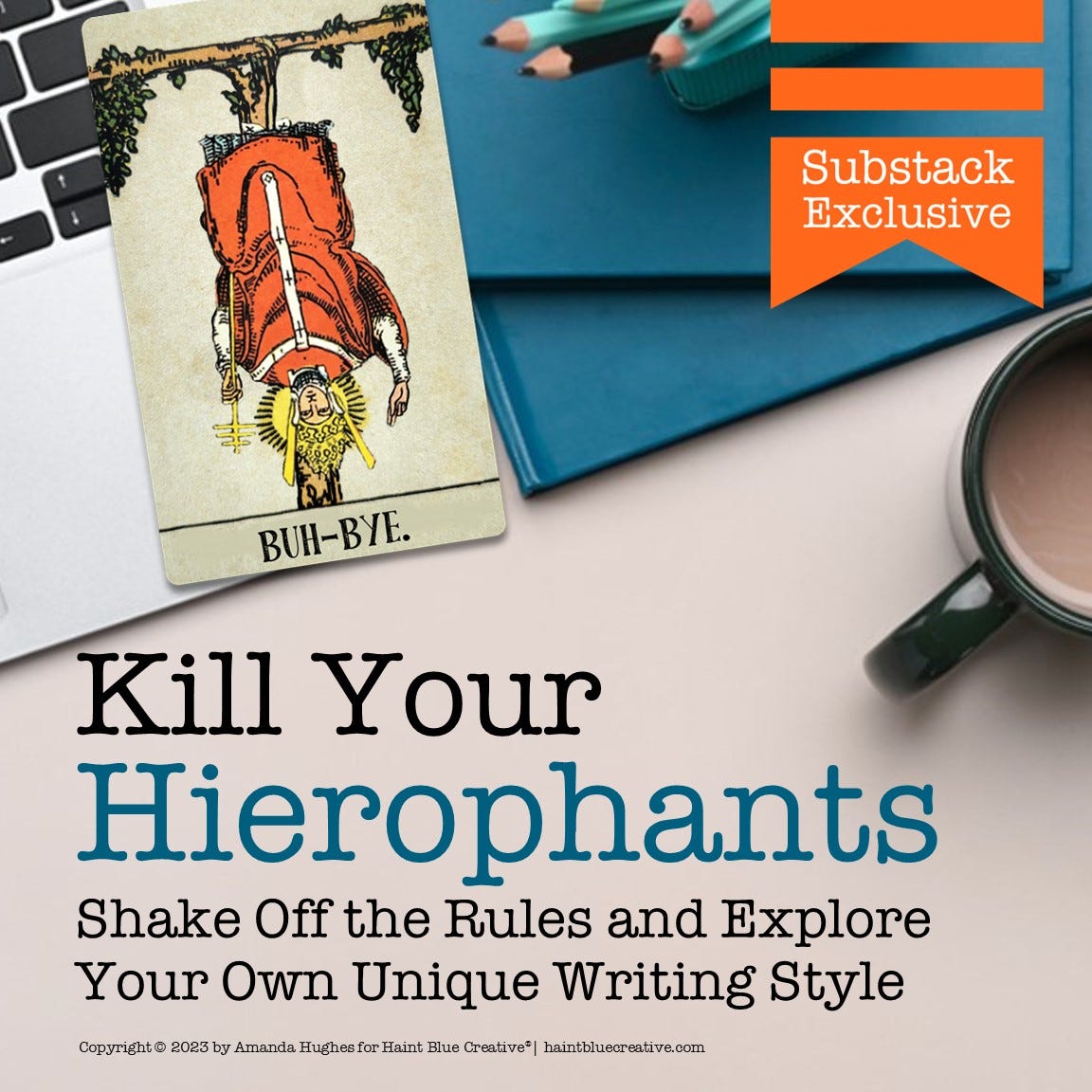*No Hierophants were harmed in the drafting of this post (although they were threatened a little...).
You’ve heard the phrase “Kill your darlings,” right?
Originally posed by English author Sir Aurthur Quiller-Couch, this popular recommendation advises writers to remove from a story all the unnecessary frills and details that might detract from the message and/or plot. Doing so renders the story easier for the reader to follow, allowing them to see it unfold in their mind’s eye. The phrase was adapted by the Horror Hierophant himself, Stephen King, in his book On Writing as he instructs, “Kill your darlings, kill your darlings, even when it breaks your egocentric little scribbler’s heart, kill your darlings.”
Today, I’d like to invite you to consider writing rules and recommendations like this one, and then decide for yourself which support your own unique and authentic style.
In the tarot, The Hierophant is the keeper and deliverer of indoctrinated beliefs and rules, the revealer of sacred things. In his lowest (most irritating) polarity, he preaches adherence and compliance within the parameters of man-made laws and other institutional constructs. Such rules can feel dogmatic, as if the paper pontiff were chastising those who think and act freely outside the box. On a positive note, The Hierophant is a sage teacher, imparting wisdom and strategies for navigating what can be a cruel world. In storytelling, protagonists—the Hero / Fool—lean on such knowledge in order to navigate the twists and turns (and unexpected road apples) that await them along their new endeavors.
If you’re only just getting to know me, I’m a faithful advocate of creative authenticity; remain true to yourself (and/or Self) and allow it to resonate through your work. As such, writing authentically requires storytellers to break The Hierophant’s rules. Doing so promotes unwavering honesty and truth, allowing stories to flow freely onto the page without regard for what anyone might think or say about the details. See more in my post Writing Fearlessly and Authentically: Five Considerations for Every Storyteller.
To write authentically, you have to kill your Hierophants. Shake off the writing rules and explore your own unique voice. Well, some of the rules. Many writing conventions should not be compromised or overlooked, like punctuation, avoiding slander and insensitivity, and grammar. However, when writing dialogue and dialect grammar rules adapt. Fragmented sentences become prose, and dialectical cadence can not only provide the reader with a clear picture of your characters, time, and setting, but it can allow those characters to show your story more effectively than you merely telling it. I expand on story-SHOWing in my post Storytelling vs Story-SHOWing: How the Tarot and Your Five Senses Can Help You Show Your Story. This post includes a complimentary template you can download for easy practice.
During my decades’ experience in both fiction and nonfiction writing, I’ve adapted the writing rules that make the most sense to my own writing style, and I’d love to share my favorite methods with you so that you might feel inspired to discover your own unique voice.
Start somewhere, start simple, quiet that inner critic, and lean in toward your intuitive thoughts. Some might interpret this as “write what you know.” Write what’s familiar to you, yes, but also write what feels right. What stories are beckoning for you to pen them? Are there characters lining up in your idea queue waiting for you to give them life? For me, ideas like these have been the best places to start, and doing so has uncovered hordes of intriguing family systems and magical plot lines that bend several writing rules.
Whether at the start of your day or as you’re winding down, journaling your thoughts can be an extremely effective method for allowing your writing style to find itself. Like unleashing your pup over at the neighborhood dog park, journaling allows your thoughts to run free, only fenced-in by the page’s edge. That page, however, is a practice field, so to speak, and it has an unlimited potential for capturing and nurturing imagination. And the world needs to see your imagination, so allow it to roam without restraint.
When I was in the third grade, my teacher introduced our class to haiku. While I’d enjoyed poetry since I was a toddler, what with my Gran stocking my bookshelves with Mother Goose, the Brothers Grimm, and Aesop’s fables, I’d never heard of a poem that didn’t rhyme. Even more fascinating, haiku allowed an entire story to unfold across three lines of only 17 syllables! The notion was pure magic, as if crafting a spell, and I quickly learned that writing haiku exercised my brain. It required me to think unconventionally about words and rhythm and messaging. With haiku, less is more, and I enjoyed the challenge and reward of figuring out how to shape a profound story in such a small space.
With freewriting, there is no associated structure or formula. The method simply allows one’s thoughts to flow freely onto the page without interruption, overthinking, or editing. Freewriting is the epitome of writing intuitively because the technique captures one’s immediate thoughts—the ones that linger beneath the surface, either subconsciously or entirely unconscious. By writing on impulse, without concern for the rules, storytellers can uncover ideas that can become long-term themes, we can tackle writer’s block, and even relieve the anxiety of not writing, or not knowing what to write. Of course, as a fan of The Office, this notion reminds me of Michael Scott when he said, “Sometimes I’ll start a sentence, and I don’t even know where it’s going. I just hope I find it along the way. Like an improv conversation... an improversation.”
Writing doesn’t mean you have to be sitting at a computer, behind a desk, in a quiet space. To some, these conditions sound like heaven! But here on Earth, it can be challenging to find the perfect provisions for penning a best seller. Sometimes, your unique writing style can be found while on the move. Kill those Hierophants of location expectation! Get moving. Write on your phone. Record voice notes while on your daily walk, commute (hands-free, of course), or while parked in the pick-up line. Heck, wherever you find yourself waiting, whip out that phone and capture notes you can use to plan your next big project. Who knows? The key to finding your voice just might be through recording voice notes.
What did you think about this post? Leave a comment and share! As always, thank you for your support of my own Hierophant killin’ escapades.
About Mandy
Amanda "Mandy" Hughes is an author and instructional designer who uses the tarot to inspire storytelling. Her book Mystic Storyteller: A Writer’s Guide to Using the Tarot for Creative Inspiration and companion tarot deck are helping her peers do exactly that. She also writes fiction under pen name A. Lee Hughes. Mandy lives in Georgia with her husband and four sons, two of whom are furrier than the others (but not by much). Visit her website at www.haintbluecreative.com and find her on Substack @HaintBlueCreative.










